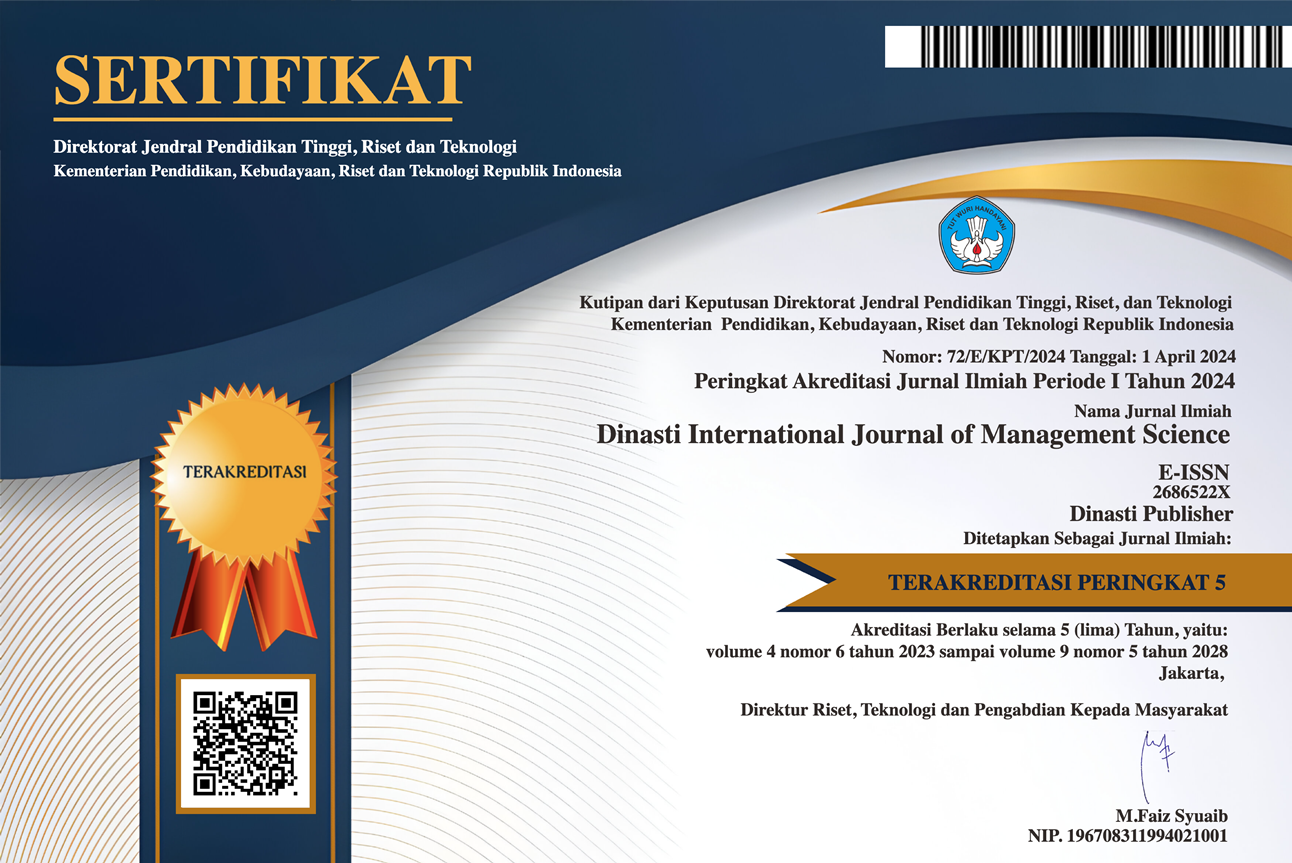Comparative Study on E-Government Implementation: Lessons from Developed and Developing Countries
DOI:
https://doi.org/10.38035/dijms.v6i4.4570Keywords:
E-Government Developed Countries, E-Government Developing Countries, Challenges Success Factors of E-Government, Best Practices of E-Government, E-Government Cross-Country ComparisonAbstract
This study uses a Systematic Literature Review (SLR) approach to compare e-government implementation in developed and developing countries based on 2014-2025 literature. The findigs show that developed countries excel in digital infrastructure maturity, integrated policies, use-centric services, and strong data protection. In contrast, developing countries continue to face various challenges. The success of e-government is not only determined by technology, but also institutions, digital leadership, and public participation. This study recommends the formulation of an inclusive national e-government strategy, strengthening regulations, and public engagement as the key to effective and sustainable public sector digital transformation.
References
Ahmed, A. M., Moreton, R., Mehdi, Q. H., & Elmaghraby, A. (2013). E-government services challenges and opportunities for developing countries: The case of Libya. 2013 2nd International Conference on Informatics and Applications, ICIA 2013, 133–137. https://doi.org/10.1109/ICoIA.2013.6650243
Ahmed, A. M., Moreton, R., Mehdi, Q. H., & Elmaghraby, A. (2013). E-government services challenges and opportunities for developing countries: The case of Libya. 2013 2nd International Conference on Informatics and Applications, ICIA 2013, 133–137. https://doi.org/10.1109/ICoIA.2013.6650243
Al-Hujran, O., Al-Debei, M. M., Chatfield, A., & Migdadi, M. (2015). The imperative of influencing citizen attitude toward e-government adoption and use. Computers in Human Behavior, 53, 189–203. https://doi.org/10.1016/j.chb.2015.06.025
Alkhwaldi, A., Kamala, M., & Qahwaji, R. (2018). Analysis of cloud-based e-government services acceptance in Jordan?: challenges and barriers Link to Item Analysis of Cloud-Based E-government Services Acceptance in Jordan?: School of Electrical Engineering and Computer Science. Journal of Internet Technology and Secured Transactions, 6(2), 556–568.
Amegavi, G. B., Bawole, J. N., & Buabeng, T. (2018). The dynamics of e-government enactment in a developing country public sector organisation: Evidence from Ghana. International Journal of Electronic Governance, 10(1), 74–92. https://doi.org/10.1504/IJEG.2018.091267
Basu, S. (2004). E?government and developing countries: an overview. International Review of Law, Computers & Technology, 18(1), 109–132. https://doi.org/10.1080/13600860410001674779
Becker, J. (2012). Innovation: A factor explaining e-government success in Estonia. Electronic Government, 9(2), 142–157.
Björklund, F. (2016). E-government and moral citizenship: the case of Estonia. Citizenship Studies, 20(6–7), 914–931. https://doi.org/10.1080/13621025.2016.1213222
Carter, L., Weerakkody, V., Phillips, B., & Dwivedi, Y. K. (2016). Citizen Adoption of E-Government Services: Exploring Citizen Perceptions of Online Services in the United States and United Kingdom. Information Systems Management, 33(2), 124–140. https://doi.org/10.1080/10580530.2016.1155948
Chen, Y. N., Chen, H. M., Huang, W., & Ching, R. K. H. (2008). E-government strategies in developed and developing countries: An implementation framework and case study. Selected Readings on Global Information Technology: Contemporary Applications, 14(1), 327–345. https://doi.org/10.4018/978-1-60566-116-2.ch020
Chohan, S. R., & Hu, G. (2022). Strengthening digital inclusion through e-government: cohesive ICT training programs to intensify digital competency. Information Technology for Development, 28(1), 16–38. https://doi.org/10.1080/02681102.2020.1841713
Elbahnasawy, N. G. (2014). E-Government, Internet Adoption, and Corruption: An Empirical Investigation. World Development, 57, 114–126. https://doi.org/10.1016/j.worlddev.2013.12.005
Elgohary, E. (2019). E-Government Implementation in Developing Countries: A Literature Review. International Journal of Computer and Technology, 16(1), 7510–7524.
Enaifoghe, A., & Ndebele, N. (2023). Examining the barriers to the adoption and integration of information communication technologies as e-Government in Africa. International Journal of Research in Business and Social Science (2147- 4478), 12(7), 383–393. https://doi.org/10.20525/ijrbs.v12i7.2723
Gil-Garcia, J. R., Dawes, S. S., & Pardo, T. A. (2018). Digital government and public management research: finding the crossroads. Public Management Review, 20(5), 633–646. https://doi.org/10.1080/14719037.2017.1327181
Goloshchapova, T., Yamashev, V., Skornichenko, N., & Strielkowski, W. (2023). E-Government as a Key to the Economic Prosperity and Sustainable Development in the Post-COVID Era. Economies, 11(4), 1–23. https://doi.org/10.3390/economies11040112
Gunawong, P., & Gao, P. (2017). Understanding e-government failure in the developing country context: a process-oriented study. Information Technology for Development, 23(1), 153–178. https://doi.org/10.1080/02681102.2016.1269713
Gyamfi, G. D., Gyan, G., Ayebea, M., & Nortey, F. N. N. (2019). Assessing the factors affecting the implementation of e-government and effect on performance of DVLA. International Journal of Electronic Government Research, 15(1), 47–61. https://doi.org/10.4018/IJEGR.2019010104
Jun, K. N., & Weare, C. (2014). Institutional motivations in the adoption of innovations: The case of e-government. Journal of Public Administration Research and Theory, 21(3), 495–519. https://doi.org/10.1093/jopart/muq020
Kumar, B. (2020). Impact of Digital India on Indian Economy. International Education & Research Journal, 6(3), 1–13. https://anubooks.com/uploads/special/16848423941.pdf#page=126
Majeed, B., Niazi, H. A. K., & Sabahat, N. (2019). E-government in developed and developing countries: A systematic literature review. Proceedings - 2019 International Conference on Computing, Electronics and Communications Engineering, ICCECE 2019, 112–117. https://doi.org/10.1109/iCCECE46942.2019.8941963
Manoharan, A. P., Ingrams, A., Kang, D., & Zhao, H. (2021). Globalization and Worldwide Best Practices in E-Government. International Journal of Public Administration, 44(6), 465–476. https://doi.org/10.1080/01900692.2020.1729182
Meiyanti, R., Utomo, B., Sensuse, D. I., & Wahyuni, R. (2019). E-Government Challenges in Developing Countries: A Literature Review. 2018 6th International Conference on Cyber and IT Service Management, CITSM 2018, Citsm, 1–6. https://doi.org/10.1109/CITSM.2018.8674245
Mohammed, F., Ibrahim, O., & Ithnin, N. (2016). Factors influencing cloud computing adoption for e-government implementation in developing countries: Instrument development. Journal of Systems and Information Technology, 18(3), 297–327. https://doi.org/10.1108/JSIT-01-2016-0001
Morte-Nadal, T., & Esteban-Navarro, M. A. (2022). Digital Competences for Improving Digital Inclusion in E-Government Services: A Mixed-Methods Systematic Review Protocol. International Journal of Qualitative Methods, 21, 1–9. https://doi.org/10.1177/16094069211070935
Mudawi, N. Al, Beloff, N., & White, M. (2020). Issues and Challenges: Cloud Computing e-government in developing countries.pdf. 11(4), 7–11.
Müller, S. D., & Skau, S. A. (2015). Success factors influencing implementation of e-government at different stages of maturity: A literature review. International Journal of Electronic Governance, 7(2), 136–170. https://doi.org/10.1504/IJEG.2015.069495
Ndou, V. (2004). E – Government for Developing Countries: Opportunities and Challenges. Electronic Journal of Information Systems in Developing Countries, 18(1), 1–24. https://doi.org/10.1002/j.1681-4835.2004.tb00117.x
Nulhusna, R., Sandhyaduhita, P. I., Hidayanto, A. N., & Phusavat, K. (2017). The relation of e-government quality on public trust and its impact on public participation. Transforming Government: People, Process and Policy, 11(3), 393–418. https://doi.org/10.1108/TG-01-2017-0004
Page, M. J., McKenzie, J. E., Bossuyt, P., Boutron, I., Hoffmann, T. C., Mulrow, C. D., Shamseer, L., Tetzlaff, J. M., Akl, E., Brennan, S. E., Chou, R., Glanville, J., Grimshaw, J. M., Hróbjartsson, A., Lalu, M. M., Li, T., Loder, E. W., Mayo-Wilson, E., McDonald, S., … Moher, D. (2021). The prisma 2020 statement: An updated guideline for reporting systematic reviews. Medicina Fluminensis, 57(4), 444–465. https://doi.org/10.21860/medflum2021_264903
PANRB. (2025). Indeks SPBE Nasional Meningkat, Menteri Rini: Penguatan Integrasi Pelayanan Publik Berbasis Digital. PANRB. https://www.menpan.go.id/site/berita-terkini/indeks-spbe-nasional-meningkat-menteri-rini-penguatan-integrasi-pelayanan-publik-berbasis-digital
Ramli, R. M. (2017). E-government implementation challenges in malaysia and south korea: A comparative study. Electronic Journal of Information Systems in Developing Countries, 80(1), 1–26. https://doi.org/10.1002/j.1681-4835.2017.tb00591.x
Roztocki, N., Strzelczyk, W., & Weistroffer, H. R. (2024). Impact of COVID-19 on e-government: a pilot study of Poland. Information Technology for Development, 1–22. https://doi.org/10.1080/02681102.2024.2361477
Safiul Hoque, S. M. (2020). Government Information and Service Delivery through Union Digital Centers in Bangladesh: Users’ Perceptions on Good Governance. International Journal of Electronic Government Research, 16(3), 45–64. https://doi.org/10.4018/IJEGR.2020070103
Scupola, A. (2019). Digital Transformation of PublicAdministration Services in Denmark:A Process Tracing Case Study. Nordic and Baltic Journal of Information and Communications Technologies, 2018(1), 261–284. https://doi.org/10.13052/nbjict1902-097x.2018.014
Sharif, A., Ranzi, M., Carbone, R., Sciarretta, G., Marino, F. A., & Ranise, S. (2022). The eIDAS Regulation: A Survey of Technological Trends for European Electronic Identity Schemes. Applied Sciences (Switzerland), 12(24). https://doi.org/10.3390/app122412679
Siddiquee, N. A. (2016). E-government and Transformation of Service Delivery in Developing Countries: The Bangladesh Experience and Lessons. Transforming Government: People, Process and Policy, 10(3), 368–390. https://doi.org/10.1108/tg-09-2015-0039
Strategy for Denmark ’ S (Issue February 2021). (2023).
Sullivan, C., & Burger, E. (2017). E-residency and blockchain. Computer Law and Security Review, 33(4), 470–481. https://doi.org/10.1016/j.clsr.2017.03.016
Turner, M., Kim, J., & Kwon, S. H. (2022). The Political Economy of E-Government Innovation and Success in Korea. Journal of Open Innovation: Technology, Market, and Complexity, 8(3). https://doi.org/10.3390/joitmc8030145
United, N. (2024). E-Government Survey 2024.
Yakhshiboyev, R. E., & Kudratillayev, M. B. (2024). Implementing E-Government Solutions: Best Practices and Challenges. “Innovations in Science and Technologies” Scientific Electronic Journal, 1, 107–117.
Yang, J., Kwon, Y., & Kim, D. (2021). Regional Smart City Development Focus: The South Korean National Strategic Smart City Program. IEEE Access, 9, 7193–7210. https://doi.org/10.1109/ACCESS.2020.3047139
Yudha, H., & Susanto, T. D. (2019). E-Leadership: The Effect of E-Government Success in Indonesia. Journal of Physics: Conference Series, 1201(1). https://doi.org/10.1088/1 742-6596/1201/1/012025
Zheng, Y., & Manoharan, A. P. (2016). The Influence of Government Capacity on E-Services Diffusion at Municipal Level in New Jersey. International Journal of Public Administration in the Digital Age, 3(4), 1–9. https://doi.org/10.4018/ijpada.2016100101
Downloads
Published
How to Cite
Issue
Section
License
Copyright (c) 2025 Wafiq Azizah Reski Amaliah, Haliah Haliah, Nirwana Nirwana

This work is licensed under a Creative Commons Attribution 4.0 International License.
Authors who publish their manuscripts in this journal agree to the following conditions:
- The copyright on each article belongs to the author(s).
- The author acknowledges that the Dinasti International Journal of Management Science (DIJMS) has the right to be the first to publish with a Creative Commons Attribution 4.0 International license (Attribution 4.0 International (CC BY 4.0).
- Authors can submit articles separately, arrange for the non-exclusive distribution of manuscripts that have been published in this journal into other versions (e.g., sent to the author's institutional repository, publication into books, etc.), by acknowledging that the manuscript has been published for the first time in the Dinasti International Journal of Management Science (DIJMS).
















































